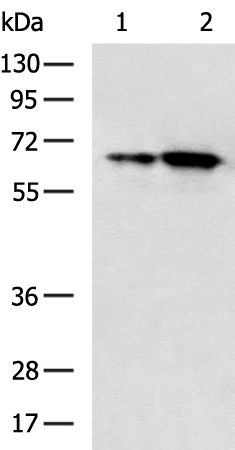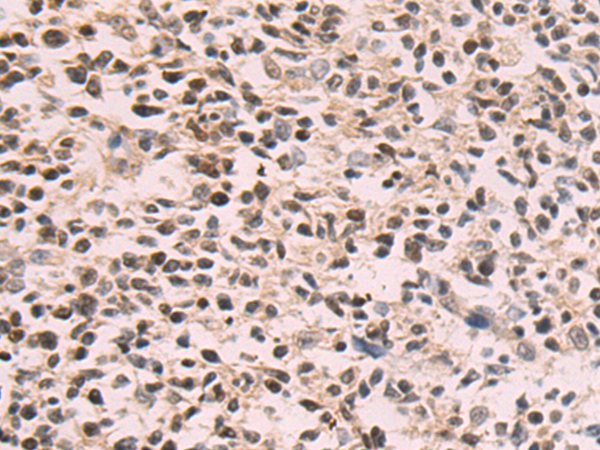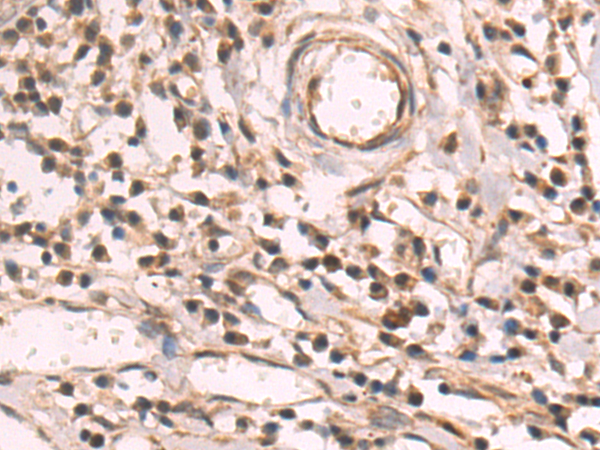


| WB | 咨询技术 | Human,Mouse,Rat |
| IF | 咨询技术 | Human,Mouse,Rat |
| IHC | 1/50-1/200 | Human,Mouse,Rat |
| ICC | 技术咨询 | Human,Mouse,Rat |
| FCM | 咨询技术 | Human,Mouse,Rat |
| Elisa | 1/5000-1/10000 | Human,Mouse,Rat |
| Aliases | PRO9856; SMARCI2; LAVS3040 |
| WB Predicted band size | 67 kDa |
| Host/Isotype | Rabbit IgG |
| Antibody Type | Primary antibody |
| Storage | Store at 4°C short term. Aliquot and store at -20°C long term. Avoid freeze/thaw cycles. |
| Species Reactivity | Human, Mouse |
| Immunogen | Fusion protein of human BRD9 |
| Formulation | Purified antibody in PBS with 0.05% sodium azide and 50% glycerol. |
+ +
以下是关于BRD9抗体的参考文献及其摘要内容:
---
1. **文献名称**:*BRD9 is a critical component of the BAF chromatin remodeling complex in AML*
**作者**:Hohmann AF, et al.
**摘要**:本研究利用BRD9抗体进行ChIP-seq和免疫共沉淀实验,揭示了BRD9在急性髓系白血病(AML)细胞中通过BAF复合体调控基因表达的关键作用,抑制BRD9可诱导白血病细胞分化。
2. **文献名称**:*Structural insights into BRD9 interactions with chromatin remodeling complexes*
**作者**:Kadoch C, et al.
**摘要**:通过BRD9抗体介导的结构生物学分析,阐明了BRD9在BAF复合体中的结合模式及其与染色质重塑的关联,为癌症相关突变对复合体功能的影响提供了机制解释。
3. **文献名称**:*Targeting BRD9 in cancer therapy: mechanisms and small molecule inhibitors*
**作者**:Filippakopoulos P, et al.
**摘要**:研究开发了选择性靶向BRD9的小分子抑制剂,并利用BRD9抗体验证其抑制效果,证明阻断BRD9可显著抑制多种癌细胞的增殖和存活。
4. **文献名称**:*Functional characterization of BRD9 in chromatin remodeling and oncogenesis*
**作者**:Shi J, et al.
**摘要**:结合CRISPR基因编辑和BRD9抗体实验,证实BRD9通过调控SMARCC2等染色质重塑因子影响致癌基因表达,为靶向治疗提供了理论依据。
---
这些研究展示了BRD9抗体在机制研究、结构分析和治疗开发中的广泛应用。如需具体文献来源,建议通过PubMed或Web of Science检索标题及作者以获取全文。
The bromodomain-containing protein 9 (BRD9) is a member of the BET (bromodomain and extraterminal) family, which plays a critical role in epigenetic regulation by recognizing acetylated lysine residues on histones. BRD9 is a core component of the non-canonical BAF (ncBAF or GBAF) chromatin remodeling complex, influencing gene expression by modulating chromatin structure. Unlike other BET proteins (e.g., BRD4), BRD9 exhibits distinct functional roles, including regulating lineage-specific genes and maintaining cellular identity. Its involvement in diseases, particularly cancer and inflammatory disorders, has garnered significant research interest. For example, BRD9 has been implicated in synovial sarcoma and acute myeloid leukemia (AML), where its dysregulation contributes to oncogenic transcriptional programs.
BRD9 antibodies are essential tools for studying its biological functions, interactions, and expression patterns. These antibodies enable techniques such as immunoprecipitation, Western blotting, and immunofluorescence, aiding in the exploration of BRD9’s role in chromatin remodeling and disease mechanisms. Additionally, BRD9-targeting probes, including selective inhibitors and degraders, are being developed for therapeutic applications. However, challenges remain in ensuring antibody specificity due to structural similarities among BET family members. Recent advancements in antibody validation, such as CRISPR-based knockout controls, have improved reliability. Research on BRD9 continues to uncover its potential as a biomarker or drug target, highlighting its importance in both basic science and translational medicine.
×